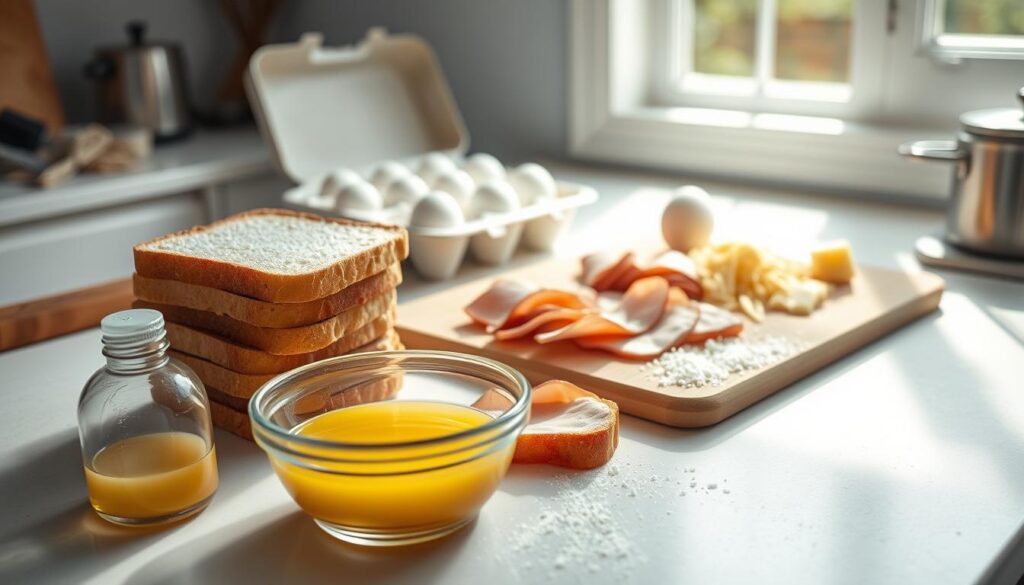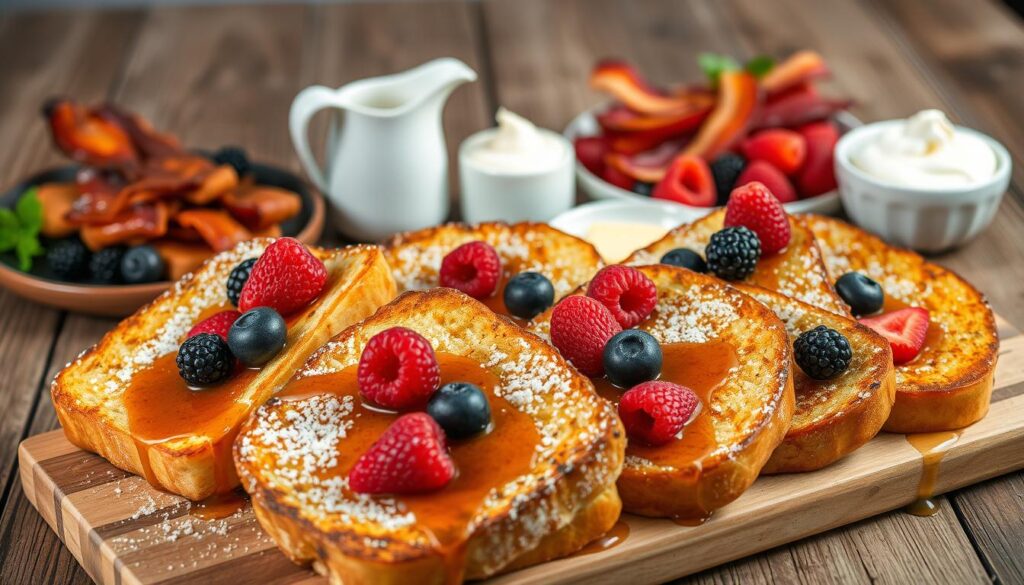Imagine starting your day with a deliciously savory breakfast that’s both easy to make and satisfying. You’re in the right place! Our cheese and ham French toast recipe is perfect for breakfast, brunch, or even a quick dinner.
This savory twist on a classic dish combines egg-soaked bread with flavorful ham and melted cheese for a mouth-watering treat. Whether you’re a beginner or an experienced cook, this recipe is versatile and offers tips to elevate this simple dish.
You’ll learn how to select the right ingredients and master the cooking technique for golden, crispy exteriors and melty interiors. Get ready to impress your family and friends with this easy yet impressive recipe.
Key Takeaways
- Learn to make a delicious cheese and ham French toast recipe
- Discover the right ingredients and cooking techniques
- Elevate your cooking skills with tips for beginners and experienced cooks
- Perfect for breakfast, brunch, or a quick dinner
- Impress your family and friends with this easy yet impressive recipe
What Makes Cheese And Ham French Toast Special
Savory ham and melted cheese transform traditional French toast into a delightful dish. Unlike its sweet counterpart, this version combines the comforting texture of egg-soaked bread with ham and cheese for a complete meal.
Several factors make this dish stand out. It offers a textural experience with its crispy exterior and gooey cheese interior. This cheese French toast is versatile, suitable for any meal of the day.
- The contrast between the crispy exterior and the gooey interior elevates this dish beyond ordinary breakfast fare.
- The versatility of ham cheese French toast makes it suitable for breakfast, lunch, or dinner.
- It transforms simple ingredients into something greater than the sum of its parts, making it both economical and impressive.
- The make-ahead potential of this dish makes it perfect for busy mornings or entertaining guests.
By combining these elements, cheese and ham French toast becomes a unique and satisfying meal option that can be adapted to various tastes and preferences.
The Best Cheese And Ham French Toast: Ingredients You’ll Need
The foundation of a mouth-watering cheese and ham French toast is built upon the quality of its ingredients. To create this dish, you’ll need to carefully select each component to ensure a harmonious balance of flavors and textures.
Bread Selection: Finding the Perfect Loaf
For the bread, opt for a soft French bread or brioche. These types of bread provide the ideal texture to absorb the egg mixture while maintaining their structure. A loaf cut into ½-inch-thick slices works best.
Cheese Options: From Cheddar to Your Preference
The cheese component can be tailored to your taste. Mild cheddar is a popular choice, but you can also experiment with Swiss, Gruyere, or American cheese, depending on your preference for meltability and flavor intensity.
Ham Selection: Thickness and Flavor
When selecting ham, look for slices about ¼-inch thick that offer a balance of saltiness and smokiness. Quality deli ham or leftover holiday ham both work excellently in this recipe.
Egg Mixture Components: Eggs, Cream, and Seasonings
The egg mixture requires eggs combined with either milk or heavy cream for richness and proper soaking. Additional ingredients like Dijon mustard, salt, and butter enhance the flavor profile. You can also customize the mixture with optional seasonings such as black pepper or herbs.
To summarize, the essential ingredients include 8 slices of bread, 4 slices of cheese, 4 slices of cooked ham, 4 eggs, 2⁄3 cup of heavy cream or 2 cups of milk, 1⁄2 teaspoon of salt, and 2 tablespoons of soft butter. By choosing high-quality ingredients, you’ll be well on your way to creating an exceptional cheese and ham French toast.
Kitchen Equipment Required
To achieve the ideal cheese french toast, certain kitchen tools are essential. The right equipment ensures that your French toast cooks evenly and has the perfect texture.
Essential Tools
You’ll need a few key items to make your cheese and ham French toast a success. A large, heavy-bottomed skillet or griddle is crucial for achieving even heat distribution. You’ll also need a shallow, wide bowl for the egg mixture, allowing for easy dipping of the bread slice without breaking them. A sturdy spatula with a thin edge is necessary for flipping the sandwiches.
- A large, heavy-bottomed skillet or griddle for even cooking
- A shallow bowl for the egg mixture
- A sturdy spatula for flipping
Optional but Helpful Items
While not necessary, some additional tools can make the process easier. A whisk can help thoroughly combine the egg mixture, and a serrated knife is useful for cleanly sliceing the bread. A kitchen thermometer can also be helpful in monitoring the cooking temperature to achieve the perfect golden crust.
- A whisk for mixing the egg mixture
- A serrated knife for slicing bread
- A kitchen thermometer for temperature control
Preparing Your Ingredients
Proper preparation of your ingredients is vital for achieving the best flavor and texture in your French toast. This step ensures that your Cheese And Ham French Toast turns out delicious and satisfying.
Slicing and Measuring
Begin by cutting your bread into even slices, approximately ½-inch thick if not pre-sliced. Ensuring they’re substantial enough to hold the filling but not so thick that the egg mixture can’t penetrate is crucial.
Creating the Perfect Egg Mixture
For the egg mixture, thoroughly beat together eggs, cream or milk, and salt in a wide, shallow dish until completely combined with no visible egg whites remaining. This mixture is the foundation of your French toast’s flavor and texture.
Assembling Your Sandwiches
When assembling your sandwiches, spread a thin layer of butter on one side of each bread slice, followed by a light coating of mustard. Then, layer cheese and ham on half of the bread slices. Consider using two different cheese varieties for a more complex flavor.
| Ingredient | Quantity | Purpose |
|---|---|---|
| Bread | 8 slices | Base of the French toast |
| Eggs | 4 | Egg mixture |
| Cheese | As needed | Filling and flavor |
| Ham | As needed | Filling and flavor |
| Butter | As needed | Flavor and browning |

Step-by-Step Cooking Instructions
With your ingredients ready, let’s dive into the step-by-step process of making the perfect ham cheese French toast. The key to achieving golden brown perfection lies in the details of the cooking process.
Preheating and Preparing Your Pan
Begin by preheating your skillet or griddle over medium heat until it’s evenly warm. Too hot, and your ham cheese French toast will burn before the inside warms; too cool, and it will absorb too much oil. Add a tablespoon of butter to the pan and allow it to melt completely, swirling to coat the cooking surface evenly for perfect browning.
Dipping Technique for Even Coating
When dipping your assembled sandwiches into the egg mixture, hold each one for about 3-5 seconds per side. This ensures they absorb some liquid without becoming soggy. As you dip, be gentle to avoid breaking the sandwich.
Cooking to Golden Perfection
Place the dipped sandwiches in the preheated pan with enough space between them to allow for easy flipping. Cook each side for approximately 3-4 minutes until golden brown, adjusting the heat as needed. Use a spatula to gently press down on the sandwiches occasionally during cooking, which helps with even browning and ensures good contact between the cheese and ham for proper melting.
Keeping Warm While Cooking in Batches
If cooking multiple batches, transfer finished toast to a baking sheet in a 200°F oven to keep warm without drying out. The total cooking time should be about 6-8 minutes per sandwich, but always judge by the golden color and melted cheese rather than strictly by time.
| Cooking Stage | Action | Result |
|---|---|---|
| Preheating | Heat pan over medium heat | Evenly warm pan |
| Dipping | Hold sandwich in egg mixture for 3-5 seconds | Even coating without sogginess |
| Cooking | Cook for 3-4 minutes per side | Golden brown color and melted cheese |
As a culinary expert once said,
“The art of cooking is not just about following a recipe; it’s about understanding the process and making adjustments as needed.”
This is particularly true when makingham cheese French toast, where the balance between crunch and melt is crucial.
Serving Suggestions for Your French Toast
To take your cheese and ham French toast to the next level, consider these creative serving suggestions. Serving your French toast with the right accompaniments can elevate it from a simple breakfast item to a satisfying meal.
Breakfast Pairings
For a well-rounded breakfast, pair your French toast with complementary dishes. Consider serving it with a side of fresh fruit to balance the richness of the dish. Berries or citrus segments provide a refreshing contrast. You can also serve it with crispy hash browns or roasted potatoes and a simple green salad dressed with light vinaigrette for a complete breakfast spread.
Brunch Ideas
For brunch gatherings, create a spread with your cheese and ham French toast as the centerpiece. Accompany it with a slow cooker egg casserole and fresh pastries. If you want to offer something different, a light soup like tomato bisque or butternut squash makes this dish suitable for lunch. For presentation, garnish with fresh herbs like chives or parsley, or add a small dollop of crème fraîche for an elegant touch.
| Meal Type | Suggested Pairings |
|---|---|
| Breakfast | Fresh fruit, hash browns, green salad |
| Brunch | Slow cooker egg casserole, fresh pastries |
| Lunch | Tomato bisque, butternut squash soup |

Delicious Variations of Cheese And Ham French Toast
Elevate your breakfast game with creative twists on the classic cheese and ham French toast. This beloved dish can be transformed into various mouth-watering recipes by changing the type of cheese, ham, or adding other ingredients.
Different Cheese Combinations
Experimenting with different types of cheese can significantly alter the flavor profile of your French toast. For instance, combining sharp cheddar with Monterey Jack provides a nice balance between flavor and meltability. Alternatively, using Brie with a sprinkle of blue cheese adds a sophisticated twist to the traditional recipe.
Meat Alternatives
For those looking for alternatives to ham, options like grilled portobello mushrooms, roasted red peppers, or avocado slices can be used, maintaining the delicious cheese component while catering to different dietary preferences.
Sweet and Savory Fusion Options
To create a unique fusion, try serving your ham and cheese French toast with a side of raspberry jam or a light dusting of powdered sugar, blending sweet and savory flavors. You can also incorporate a thin layer of scrambled eggs between the ham and cheese for a more substantial breakfast.
Troubleshooting Common Issues
Achieving perfect ham cheese French toast requires avoiding some common mistakes. When you follow the right techniques and adjust your approach based on the issues you encounter, you can significantly improve your results.
Causes and Solutions for Soggy Centers
Soggy centers in your ham cheese French toast can be disappointing. This issue often arises from soaking the bread slices too long in the egg mixture. To avoid this, aim for a quick dip of 3-5 seconds per side. The thickness of your bread also plays a crucial role; slices that are too thin can become waterlogged, while those that are too thick may not cook evenly. Additionally, the ratio of eggs to milk in your mixture is important – too much milk can lead to soggy results.
Preventing Burnt Exterior with Undercooked Interior
Experiencing a burnt exterior with an undercooked interior is another common issue when making ham cheese French toast. This typically occurs when the heat is too high. To resolve this, reduce the heat to medium-low and extend the cooking time. This adjustment allows for more even heat distribution, ensuring that your toast is cooked thoroughly without burning the outside.
Pro Tips for Perfect Cheese And Ham French Toast
Achieving perfection in cheese and ham French toast requires attention to detail, and these pro tips will guide you through the process. To start, let’s look at some key factors that can make or break your dish.
Bread Thickness Matters
For the perfect cheese french toast, select bread that’s slightly stale (1-2 days old) as it absorbs the egg mixture without becoming overly soggy during cooking. Maintaining a consistent slice thickness throughout all sandwiches ensures they cook at the same rate, especially when cooking for a crowd.
Egg Mixture Consistency
The egg mixture should be smooth and well combined. Allowing your assembled sandwiches to rest for 2-3 minutes after dipping in the egg mixture and before cooking ensures even absorption and better texture.
Temperature Control
Temperature control is crucial. Start with medium heat and adjust down if browning happens too quickly. The ideal toast requires time for the cheese to melt completely. Using a timer rather than relying on visual cues alone helps achieve the perfect doneness.
Make-Ahead Options
For make-ahead convenience, assemble the ham cheese sandwiches the night before and refrigerate them, then dip in the egg mixture just before cooking to save morning preparation time.
| Tip | Benefit |
|---|---|
| Use slightly stale bread | Prevents sogginess |
| Maintain consistent slice thickness | Ensures even cooking |
| Rest sandwiches after dipping | Improves texture |
| Control cooking temperature | Prevents burning and undercooking |
Nutritional Information and Dietary Considerations
Understanding the nutritional content of your Cheese And Ham French Toast is crucial for a balanced diet. A typical serving contains approximately 350-450 calories, with variations based on bread, cheese, and ham choices.
This dish is a good source of protein from eggs, ham, and cheese, making it a satisfying meal. However, it also contains significant amounts of fat from eggs, cheese, milk, and butter.
| Nutrient | Approximate Value |
|---|---|
| Calories | 350-450 per serving |
| Protein | 25-30g |
| Fat | 20-25g |
To make a lighter version, consider using reduced-fat cheese, lean ham, and cooking spray instead of butter. You can also adapt this recipe to suit dietary needs by using gluten-free bread and lactose-free milk.
Conclusion
As you’ve discovered, the cheese and ham French toast recipe is a straightforward path to a delicious meal. This dish is not just limited to breakfast; it’s versatile enough for brunch, lunch, or even a quick dinner. The combination of savory elements with the classic French toast technique creates a satisfying meal that appeals to both children and adults alike.
By experimenting with different cheese varieties and bread types, you can make this recipe your own signature dish. With practice, you’ll develop an intuitive sense for the perfect dipping time and cooking temperature. This elevated breakfast classic demonstrates that simple recipes can deliver impressive results with minimal effort.


1 thought on “The Best Cheese And Ham French Toast Recipe for You”
Comments are closed.